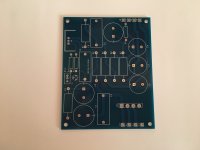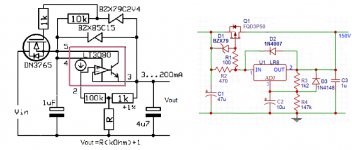Following with interest, and also I echo Anatechs comment.
Having some LND150 as well as DN2540N3 and a few J112/113 FETs, I wonder if any of these devices could be used?
I've not seen this LR8 device yet, so its news to me, and something is will need to research a little.
Having some LND150 as well as DN2540N3 and a few J112/113 FETs, I wonder if any of these devices could be used?
I've not seen this LR8 device yet, so its news to me, and something is will need to research a little.
The LR8 (and the LR12) are basically an LM317 with a high-voltage DMOS pass device. App circuits can be calculated in the same manner.
Jan
Jan
All these chickens clucking over their favourite regulators and nobody has asked you the important questions:For the TIP 150 I want to use a version with an isolated outline like TO220F (MJF13009) or SOT186A (BUT18F)
Unfortunately the Hfe of MJF13009 or BUT18F is too low.
Maybe there are a direct replacement for the TIP150 in the wanted outline.
Thank you for an advice.
What output voltage do you need?
How much current?
Short circuit proof?
Does it need to be adjustable?
Does it need to be very quiet or just cheap and dirty?
Is it for a fixed installation or a bench power supply, or...?
+1
As a friend of mine used to say:
"Specify the performance, and accept the design: the road to heaven"
"Specify the design, and accept the performance: the road to hell".
Jan
As a friend of mine used to say:
"Specify the performance, and accept the design: the road to heaven"
"Specify the design, and accept the performance: the road to hell".
Jan
Last edited:
Hi Kevin,
Just curious. Wouldn't a D-Mosfet like an LND150Nx be a little easier to deal with? You could use a DN2540Nx if you needed over 1.5 mA.
The LR8 looks like a pretty cool part. I'm going to get me some 'o those!
-Chris
I design for the load current, my designs all use high transconductance triodes and operate at the current listed or above. The LND150 would fry in seconds at these power levels. As long as the gate stopper is located at the gate I've not had a problem with any enhancement mode mosfet. I don't use depletion mode mosfet as followers in power supplies. There is no problem either way, just a design and cost consideration.
Hi Kevin,
No, for the CCS portion. There is nothing wrong with your pass transistor that I can see.
-Chris
No, for the CCS portion. There is nothing wrong with your pass transistor that I can see.
-Chris
I exclusively use the LR8, have been for years. It is deceptively simple yet super reliable, I can honestly say that I have never had an issue with it, it is rock solid, super quiet and clean!
A lot of the circuits I have seen here are good, but, in my personal opinion, over complicated, when compared to the LR8. I believe in the KISS principle! 😉
A lot of the circuits I have seen here are good, but, in my personal opinion, over complicated, when compared to the LR8. I believe in the KISS principle! 😉
Last edited by a moderator:
Hi Kevin,
No, for the CCS portion. There is nothing wrong with your pass transistor that I can see.
-Chris
Why would I replace the wonderful LR8 voltage regulator IC with a zener string and a CCS? There is no CCS in this design. I can set the voltage to anything I want, it has quite decent ripple rejection, noise performance, short circuit and thermal protection and much better precision than I could manage with a zener string. Can withstand over 400V on its input terminal. It also costs less...
I use both IXYs and Supertex depletion mode mosfets in the cascode CCS/mu-followers in my active circuitry, most are running at 10 - 20mA depending on the end purpose
Hi MontanaWay,
-Chris
If we can take you at your word, then you would absolutely love the LND150Nx and DN2540Nx D-Mosfets. A CCS consists of one resistor and one of these devices. You end up with a two terminal current source. It's done the same way as with a J-Fet.A lot of the circuits I have seen here are good, but, in my personal opinion, over complicated, when compared to the LR8. I believe in the KISS principle!
-Chris
See my comment above. CCS is nice but I like the LR8 better, just accept there is more than one way to skin the cat, and we don't all want to do things the same way as you would. I would have to use a string of qualified zeners for regulation operating at much higher current to get anything like comparable performance, more heat and more cost..
Hi Kevin,
Fair enough. I thought you were using it as a CCS after seeing the stack of resistors. Obviously I needed to look more closely at your circuit.
-Chris
Fair enough. I thought you were using it as a CCS after seeing the stack of resistors. Obviously I needed to look more closely at your circuit.
-Chris
😀 I don't advocate it as the last word, but it works well and has been very reliable in a reasonably large number of builds. I use variants of the design to power a stain gauge pre-amp and 3 different RIAA phono stage designs.
It's designed to be cost effective, a good performer and reasonably consistent in performance. Variability of output voltage from sample to sample generally seems to be around 1% or better for parts from the same lot, basic tolerance is a few % and rarely worse IMLE, zeners are 5% typically or worse and have to run at higher current for good performance, and they drift..
It's designed to be cost effective, a good performer and reasonably consistent in performance. Variability of output voltage from sample to sample generally seems to be around 1% or better for parts from the same lot, basic tolerance is a few % and rarely worse IMLE, zeners are 5% typically or worse and have to run at higher current for good performance, and they drift..
Hi MontanaWay,
If we can take you at your word, then you would absolutely love the LND150Nx and DN2540Nx D-Mosfets. A CCS consists of one resistor and one of these devices. You end up with a two terminal current source. It's done the same way as with a J-Fet.
-Chris
as I indicated, I see no reason why I should change to something else. And this is of course my personal opinion based on years of experience using the LR8.
We all have our favorites, mine just happens to be the LR8.
Hi MontanaWay,
Well, certain parts just happen to do a better job at some things than others. Like me for example, I have ten of those LR8 ICs on order now. I can see where they would work better, but then the D-Mosfet will continue to be used where its better. Another solution to a problem in my bag of tricks. That's why you should consider and play with new things, especially when they are less than a buck each
-Chris
Well, certain parts just happen to do a better job at some things than others. Like me for example, I have ten of those LR8 ICs on order now. I can see where they would work better, but then the D-Mosfet will continue to be used where its better. Another solution to a problem in my bag of tricks. That's why you should consider and play with new things, especially when they are less than a buck each
-Chris
Best thanks for all advices.
The LR8 in tube circuits – wauwatosa tube factory
The purpose of the whole is to replace a HV regulator consisting only of very hard to find high power military zener diodes in a diy tube preamplifier with the least possible effort - go to post #6 under
Help needed for unknown SEMELAB Power Zeners "8136 8215E"
The reason for the destroy of these very special diodes was that the screw connection to the heatsink was not tight.
maybe this is a good solution together with IRF820 - go towhy not just use the LR8 high voltage regulator, up to 415V and tag a TIP50 at the output...simple! All you need are a handful of parts!
The LR8 in tube circuits – wauwatosa tube factory
The purpose of the whole is to replace a HV regulator consisting only of very hard to find high power military zener diodes in a diy tube preamplifier with the least possible effort - go to post #6 under
Help needed for unknown SEMELAB Power Zeners "8136 8215E"
The reason for the destroy of these very special diodes was that the screw connection to the heatsink was not tight.
why not just use the LR8 high voltage regulator, up to 415V and tag a TIP50 at the output...simple! All you need are a handful of parts!
In the past I used a regulator based on LR8 but I found it a little noisy. I don't know if it was depending of the circuit layout or the LR8 nature itself.
- Home
- Amplifiers
- Tubes / Valves
- 300V High-Voltage Regulator for Tube Pre - Transistor wanted in TO220F resp. TO220ISO

